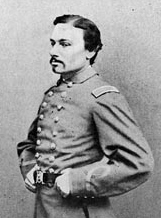SINCLAIR-ARTHUR
ARTHUR SINCLAIR IV

LT

Arthur Sinclair IV was born on May 12, 1837, in Norfolk, Virginia. Following in the footsteps of his father and grandfather, both of whom had risen to high rank in the U.S. Navy before him, he joined the Navy at an early age. It is recorded that during the 1850’s he served at sea under his father, CDR Arthur Sinclair III, but returned to civilian life by the time of the 1860-61 secession crisis. When the Confederate States Navy was established, Arthur Sinclair IV reportedly joined it in 1861 and entered with the rank of Masters Mate.
Assigned to the Confederate ironclad CSS VIRGINIA, he was aboard her during the historic four hours Battle of Hampton Roads with the Union ironclad USS MONITOR on March 9, 1862. The two ships pounded each other all morning but their armor plates easily deflected the cannon shots and neither ship was seriously damaged, signaling a new era of steam powered iron ships. The battle also effectively ended the short reign of terror that CSS VIRGINIA had brought to the Union navy. Two months after the battle, Union troops invaded the James Peninsula area of Virginia where CSS VIRGINIA was located and as she was not considered seaworthy enough to enter the Atlantic, the ship was purposely destroyed to prevent her capture by the enemy.
Sinclair was next sent to Europe where he joined the crew aboard CSS ALABAMA where he first served as Sailing Master before being promoted to the rank of Lieutenant and became a Watch Officer. CSS ALABAMA was a commerce raider and met with great success attacking Union merchant and naval ships over the course of her two year career during which she never docked at a Southern port. ALABAMA left a path of destruction attacking Union ships off New England, Gulf of Mexico and the Southern Atlantic. ALABAMA was credited with burning 65 Union vessels of various types, most of them merchant ships. During ALABAMA’s raiding ventures, captured ships’ crews and passengers were never harmed, only detained until they could be placed aboard a neutral ship or placed ashore.
In June 1864, ALABAMA arrived in Cherbourg, France, where she docked for badly needed repairs and soon the Union sloop-of war USS KEARSARGE headed a blockading force off the harbor entrance. Through diplomatic channels the ALABAMA’s commander sent a bold challenge, “My intention is to fight the KEARSARGE as soon as I can make the necessary arrangements. I hope these will not detain me more than until tomorrow or the morrow morning at farthest. I beg she will not depart until I am ready to go out.”
On June 19, ALABAMA sailed out to meet KEARSARGE. As the ships steamed on opposite courses in spiraling circles the battle turned against ALABAMA due to the superior gunnery displayed by KEARSARGE and the deteriorated state of ALABAMA’s contaminated powder and fuses. ALABAMA’s too rapid rate-of-fire resulted in frequent poor gunnery with many of her shots going too high. Historical records indicate that by the end of the battle, ALABAMA was listing badly and unable to lower its guns thus its shots were going harmlessly over KEARSARGE.
When ALABAMA sank, Lieutenant Sinclair found himself in the ocean where he was rescued by the English yacht DEERHOUND which was nearby in a fleet of boats watching the engagement. After being taken to Southampton, England, he was later assigned to the inactive cruiser CSS RAPPAHANNOCK at Calais, France. Following the Civil War he returned to the United States and primarily lived in Baltimore, Maryland, where he was a merchant. In the 1890s he wrote a book “Two Years on the Alabama.” He died in Baltimore on November 17, 1925, and is buried at Green Mount Cemetery in Baltimore.
Submitted by CDR Roy A. Mosteller, USNR (Ret)

